Aging Well Program: Attention
Click to try FREE for 15-Days.
These games train attention and working memory.
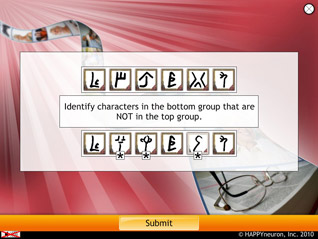
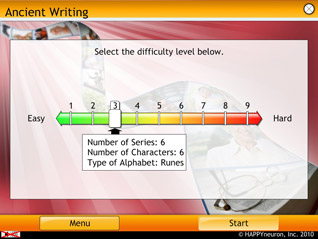

Ancient Writing
The task
In this exercise, the patient must pay close attention to two sets of characters. His task is to distinguish on the second set the characters that are different from the first set of characters.
What it trains
This exercise primarily stimulates the user's visual attention and his concentration skills. Indeed, he will have to pinpoint relevant information (differences), visually scan details and keep his mind focused on looking for differences. Whenever a person is presented with a new set of symbols, such as when learning to navigate traffic signs for the first time or when learning a language with a unique alphabet, he/she uses the skills from this activity.
Parameters
In this program, 9 levels have been specially selected to ensure an easy start and grant a regular progression.



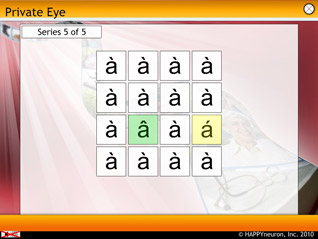
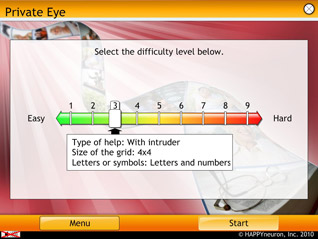
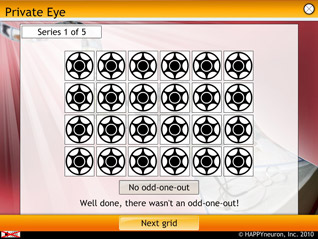
Private Eye
The task
In this task, the patient needs a discriminating eye to locate a symbol in a grid full of intricate symbols and letters (intruder) that differs from other symbols (all of which are identical), and catch the sneaky suspect that was shown before starting the task.
What it trains
Primarily, this task exercises the user's abilities for a specific type of attention called sustained attention and concentration. Attention is the essence of focus and the user will need to focus on looking for a specific target and ignore the symbols that could distract his attention. Any time a person pays attention to something, and any time he ignores something, data is created in his brain. That data has value, but only if it's gathered, measured, and analyzed. In addition, this exercise requires good visual scanning and shape recognition skills.
Parameters
In this program, 9 levels have been specially selected to ensure an easy start and grant a regular progression.



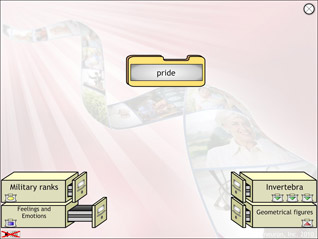
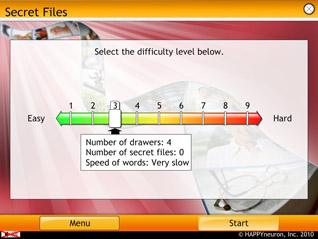
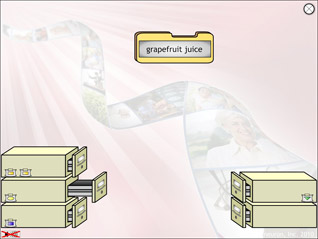
Secret Files
The task
This task requires the patient to catch words before they fall to the ground and file them in the correct secret drawer. Each drawer is devoted to a category. When he can't see the file categories in advance, he needs to discover them by himself (trial and error) and deduce which word is associated with which file.
What it trains
This exercise primarily targets concentration and executive functioning like deductive reasoning to successfully solve a problem. In this task, the user will need to engage processes such as organizing word categories, manage his time, and focus your attention to remember the right file categories, consider errors and their consequences, control his answers, and plan ahead.
Parameters
In this program, 9 levels have been specially selected to ensure an easy start and grant a regular progression.



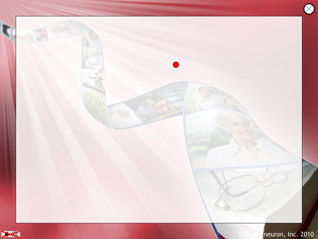

Under Pressure
The task
In this exercise, three types of stimuli (a red circle, a black cross, and a letter) will appear one after the other at different spots, anywhere on the screen. The aim is to determine quickly whether the red circle appears above or below the black cross.
What it trains
This task trains the subject's sustained attention as he has to maintain performance and vigilance over a long period of time. He has to quickly detect the stimuli and scan the whole screen. It therefore also trains his visual and spatial skills. Visual-spatial skills are a set of mental processes that allow us to perceive, interpret and act on visual stimuli in our environment. Often, people aren't even aware that they are using their visual-spatial skills. As a result, people tend to take these skills for granted. The patient has to focus on the task and not let other stimuli distract him. That means he must control his actions constantly to be effective.
Parameters
In this program, 9 levels have been specially selected to ensure an easy start and grant a regular progression.


Click to try FREE for 15-Days.
